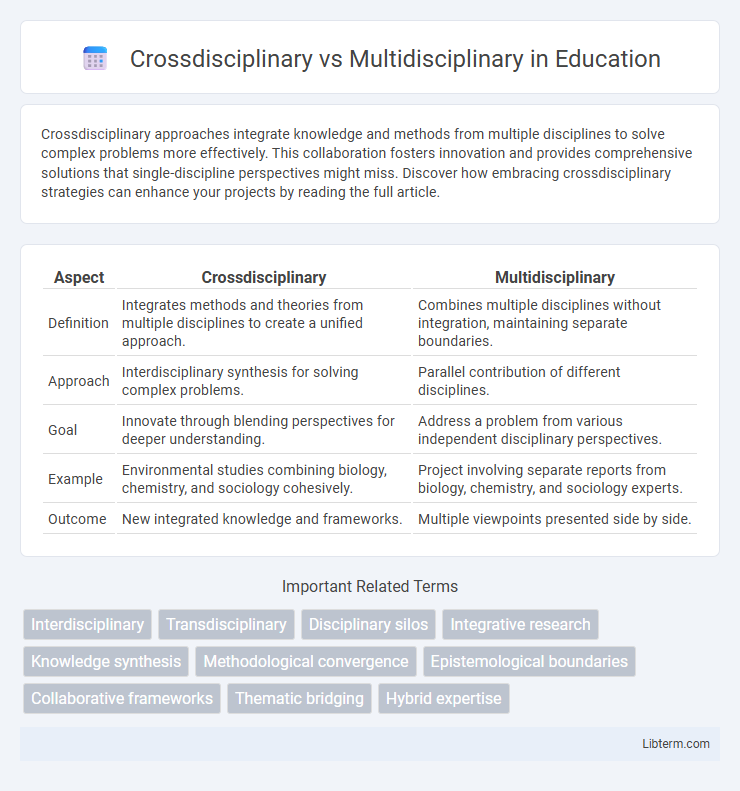Crossdisciplinary approaches integrate knowledge and methods from multiple disciplines to solve complex problems more effectively. This collaboration fosters innovation and provides comprehensive solutions that single-discipline perspectives might miss. Discover how embracing crossdisciplinary strategies can enhance your projects by reading the full article.
Table of Comparison
| Aspect | Crossdisciplinary | Multidisciplinary |
|---|---|---|
| Definition | Integrates methods and theories from multiple disciplines to create a unified approach. | Combines multiple disciplines without integration, maintaining separate boundaries. |
| Approach | Interdisciplinary synthesis for solving complex problems. | Parallel contribution of different disciplines. |
| Goal | Innovate through blending perspectives for deeper understanding. | Address a problem from various independent disciplinary perspectives. |
| Example | Environmental studies combining biology, chemistry, and sociology cohesively. | Project involving separate reports from biology, chemistry, and sociology experts. |
| Outcome | New integrated knowledge and frameworks. | Multiple viewpoints presented side by side. |
Understanding Crossdisciplinary Approaches
Crossdisciplinary approaches integrate concepts and methodologies from multiple disciplines to create new frameworks and innovative solutions beyond traditional boundaries. Unlike multidisciplinary methods that juxtapose separate disciplines without synthesis, crossdisciplinary work emphasizes holistic understanding and collaboration to address complex problems. This approach enhances creativity and problem-solving by merging diverse expert insights into cohesive strategies.
Defining Multidisciplinary Collaboration
Multidisciplinary collaboration involves experts from various disciplines working alongside each other, each contributing their specialized knowledge to address a common problem without integrating their approaches. This form of collaboration maintains distinct disciplinary boundaries while encouraging parallel contributions to achieve a collective goal. Effective multidisciplinary teams leverage diverse expertise to enhance problem-solving without the convergence seen in crossdisciplinary methods.
Key Differences Between Crossdisciplinary and Multidisciplinary
Crossdisciplinary research integrates concepts and methods from multiple disciplines to create a unified framework, enhancing problem-solving and innovation. Multidisciplinary research involves parallel contributions from different disciplines, maintaining disciplinary boundaries while addressing a common problem. The key difference lies in the level of integration: crossdisciplinary approaches blend perspectives into a cohesive whole, whereas multidisciplinary approaches keep them distinct and coordinated.
Historical Evolution of Collaborative Methods
Crossdisciplinary collaboration emerged from early 20th-century efforts to integrate knowledge across fields, emphasizing synthesis and creating new frameworks beyond traditional boundaries. Multidisciplinary methods developed primarily through mid-20th-century scientific projects, focusing on parallel contributions from distinct disciplines addressing a common problem without merging methodologies. These historical evolutions reflect a shift from isolated expertise to interconnected approaches, with crossdisciplinary methods fostering deeper integration and multidisciplinary strategies prioritizing diverse perspectives within collaborative research.
Core Benefits of Crossdisciplinary Work
Crossdisciplinary work integrates methods and perspectives from different disciplines to create innovative solutions and foster deeper understanding beyond mere collaboration. It enhances problem-solving by combining knowledge frameworks, encouraging holistic thinking, and enabling the synthesis of novel ideas that single disciplines cannot achieve alone. This approach optimizes creativity, accelerates breakthrough discoveries, and improves adaptability in complex, real-world challenges.
Advantages of Multidisciplinary Teams
Multidisciplinary teams bring together experts from diverse fields to address complex problems with varied perspectives, enhancing creativity and innovation. By leveraging specialized knowledge independently, these teams can efficiently analyze issues without the need for extensive integration, accelerating decision-making processes. This approach fosters flexibility, allowing each discipline to contribute its strengths while maintaining clear roles and responsibilities.
Common Challenges in Integration
Crossdisciplinary and multidisciplinary approaches face common challenges in integration, such as differences in terminology, methodologies, and epistemologies across disciplines. These differences create barriers to effective communication and collaboration, hindering the synthesis of knowledge. Managing diverse perspectives requires establishing clear frameworks and fostering mutual understanding to ensure cohesive outcomes.
Real-World Applications and Case Studies
Crossdisciplinary approaches integrate methods and perspectives from multiple disciplines to create new frameworks, enhancing complex problem-solving in real-world applications such as sustainable urban development and healthcare innovation. Multidisciplinary projects maintain distinct disciplinary boundaries while contributing specialized knowledge, evident in corporate environments where engineering, marketing, and finance teams collaborate on product development. Case studies highlight crossdisciplinary strategies in climate change adaptation policies, demonstrating how shared methodologies lead to comprehensive solutions, whereas multidisciplinary efforts optimize tasks by leveraging focused expertise for efficient outcomes.
Choosing the Right Approach for Your Project
Crossdisciplinary approaches integrate methods and concepts from different disciplines to create new frameworks, ideal for projects requiring innovation and deep synthesis. Multidisciplinary projects maintain distinct disciplinary methods side by side, suitable when diverse expertise is needed without blending knowledge domains. Selecting the right approach depends on the project's goals, complexity, and the level of collaboration required for effective outcomes.
Future Trends in Collaborative Research
Crossdisciplinary research integrates concepts and methods from multiple disciplines to create new frameworks, while multidisciplinary research involves parallel contributions from distinct fields addressing a common problem. Future trends emphasize the rise of hybrid teams combining artificial intelligence with human expertise to accelerate innovation and problem-solving. Advanced digital platforms and open science initiatives will further enhance cross- and multidisciplinary collaborations by enabling seamless data sharing and real-time knowledge exchange.
Crossdisciplinary Infographic

 libterm.com
libterm.com